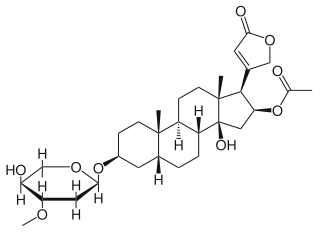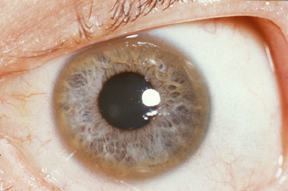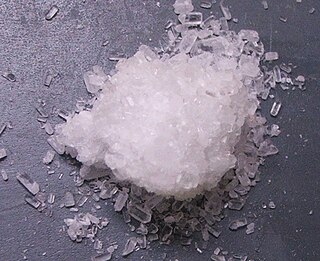Related Research Articles

Magnesium is a chemical element with the symbol Mg and atomic number 12. It is a shiny gray solid which shares many physical and chemical properties with the other five alkaline earth metals.

Poison is something that causes harm. The term is used in a wide range of scientific fields and industries, where it is often specifically defined. It may also be applied colloquially or figuratively, with a broad sense.

Defecation follows digestion, and is a necessary process by which organisms eliminate a solid, semisolid, or liquid waste material known as feces from the digestive tract via the anus. The act has a variety of names ranging from the common, like pooping, to the technical, e.g. bowel movement, to the obscene (shitting), to the euphemistic. The topic, usually avoided among polite company, can become the basis for some potty humour.

Laxatives, purgatives, or aperients are substances that loosen stools and increase bowel movements. They are used to treat and prevent constipation.

Magnesium sulfate or magnesium sulphate (in English-speaking countries other than the US) is a chemical compound, a salt with the formula MgSO4, consisting of magnesium cations Mg2+ (20.19% by mass) and sulfate anions SO2−4. It is a white crystalline solid, soluble in water but not in ethanol.

A pesticide poisoning occurs when pesticides, chemicals intended to control a pest, affect non-target organisms such as humans, wildlife, plant, or bees. There are three types of pesticide poisoning. The first of the three is a single and short-term very high level of exposure which can be experienced by individuals who commit suicide, as well as pesticide formulators. Type two poisoning is long-term high-level exposure, which can occur in pesticide formulators and manufacturers. The third type of poisoning is a long-term low-level exposure, which individuals are exposed to from sources such as pesticide residues in food as well as contact with pesticide residues in the air, water, soil, sediment, food materials, plants and animals.
Syrup of ipecac, commonly referred to as ipecac, is a drug that was once widely used as an expectorant and a rapid-acting emetic. It is obtained from the dried rhizome and roots of the ipecacuanha plant, from which it derives its name. It is no longer used in medicine.

A fecal impaction is a solid, immobile bulk of feces that can develop in the rectum as a result of chronic constipation. A related term is fecal loading which refers to a large volume of stool in the rectum of any consistency. Fecal impaction is a common result of neurogenic bowel dysfunction and causes immense discomfort and pain. Treatment of fecal impaction includes laxatives, enema, and pulsed irrigation evacuation (PIE).
A cholinergic crisis is an over-stimulation at a neuromuscular junction due to an excess of acetylcholine (ACh), as a result of the inactivity of the AChE enzyme, which normally breaks down acetylcholine.

Whole bowel irrigation (WBI) is a medical process involving the rapid administration of large volumes of an osmotically balanced macrogol solution, either orally or via a nasogastric tube, to flush out the entire gastrointestinal tract.

Phosmet is a phthalimide-derived, non-systemic, organophosphate insecticide used on plants and animals. It is mainly used on apple trees for control of codling moth, though it is also used on a wide range of fruit crops, ornamentals, and vines for the control of aphids, suckers, mites, and fruit flies.

Magnesium citrate is a magnesium preparation in salt form with citric acid in a 1:1 ratio. The name "magnesium citrate" is ambiguous and sometimes may refer to other salts such as trimagnesium citrate which has a magnesium:citrate ratio of 3:2.

Liquid paraffin, also known as paraffinum liquidum, paraffin oil, liquid paraffin oil or Russian mineral oil, is a very highly refined mineral oil used in cosmetics and medicine. Cosmetic or medicinal liquid paraffin should not be confused with the paraffin used as a fuel. The generic sense of paraffin meaning alkane led to regional differences for the meanings of both paraffin and paraffin oil. It is a transparent, colorless, nearly odorless, and oily liquid that is composed of saturated hydrocarbons derived from petroleum.
Ethylene glycol poisoning is poisoning caused by drinking ethylene glycol. Early symptoms include intoxication, vomiting and abdominal pain. Later symptoms may include a decreased level of consciousness, headache, and seizures. Long term outcomes may include kidney failure and brain damage. Toxicity and death may occur after drinking even in a small amount as ethylene glycol is more toxic than other diols.

Oleandrin is a cardiac glycoside found in the poisonous plant oleander. As a main phytochemical of oleander, oleandrin is associated with the toxicity of oleander sap, and has similar properties to digoxin.

Paracetamol poisoning, also known as acetaminophen poisoning, is caused by excessive use of the medication paracetamol (acetaminophen). Most people have few or non-specific symptoms in the first 24 hours following overdose. These include feeling tired, abdominal pain, or nausea. This is typically followed by a couple of days without any symptoms, after which yellowish skin, blood clotting problems, and confusion occurs as a result of liver failure. Additional complications may include kidney failure, pancreatitis, low blood sugar, and lactic acidosis. If death does not occur, people tend to recover fully over a couple of weeks. Without treatment, death from toxicity occurs 4 to 18 days later.

Copper toxicity is a type of metal poisoning caused by an excess of copper in the body. Copperiedus could occur from consuming excess copper salts, but most commonly it is the result of the genetic condition Wilson's disease and Menke's disease, which are associated with mismanaged transport and storage of copper ions. Copper is essential to human health as it is a component of many proteins.

Aluminium phosphide poisoning is poisoning that occurs as a result of excessive exposure to aluminium phosphide (AlP), which is readily available as a fumigant for stored cereal grains and sold under various brand names such as QuickPhos, Salphos and Celphos. Aluminium phosphide is highly toxic, especially when consumed from a freshly opened container. Acute aluminium phosphide poisoning (AAlPP) is a large though under-reported problem throughout the world, particularly in the Indian subcontinent.
Magnesium salts are available as a medication in a number of formulations. They are used to treat magnesium deficiency, low blood magnesium, eclampsia, and several other conditions. Magnesium is important to health.

Magnesium sulfate as a medication is used to treat and prevent low blood magnesium and seizures in women with eclampsia. It is also used in the treatment of torsades de pointes, severe asthma exacerbations, constipation, and barium poisoning. It is given by injection into a vein or muscle as well as by mouth. As epsom salts, it is also used for mineral baths.
References
- ↑ Cathartics at the US National Library of Medicine Medical Subject Headings (MeSH)
- ↑ The MSDS HyperGlossary: Catharsis
- ↑ American Academy Of Clinical Toxico; European Association Of Poisons Cen (2004). "Position paper: cathartics". Journal of Toxicology. Clinical Toxicology. 42 (3): 243–53. doi:10.1081/CLT-120039801. PMID 15362590.
- ↑ Tamara McGregor; et al. (2009). "Evaluation and management of common childhood poisonings". Am Fam Physician. 79 (5): 397–403. PMID 19275069.
- ↑ Roberts, James R.; Reigart, J. Routt (2013). "Other Insecticides and Acaracides" (PDF). Recognition and Management of Pesticide Poisonings (6th ed.). Washington DC: Office of Pesticide Programs, U.S. Environmental Protection Agency. p. 93.